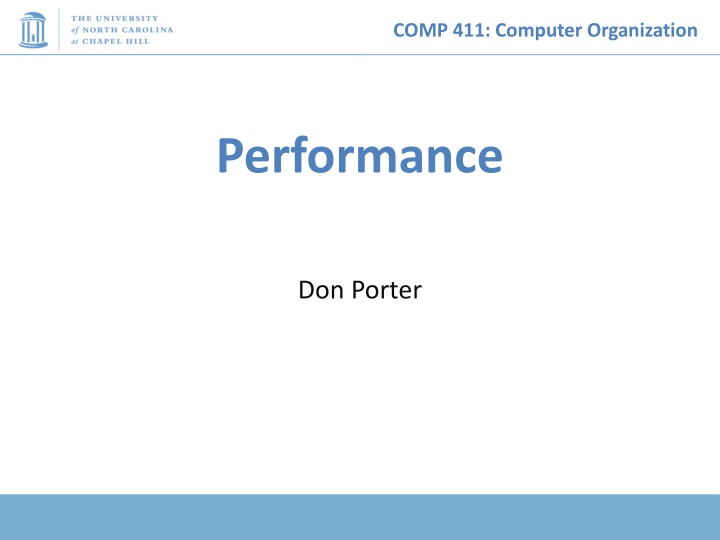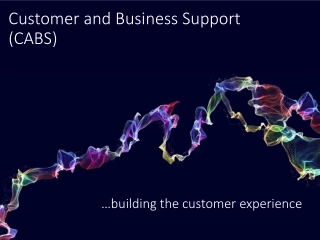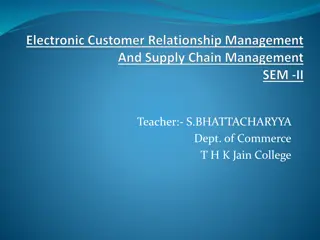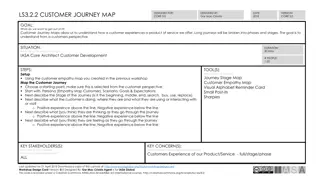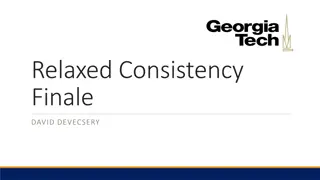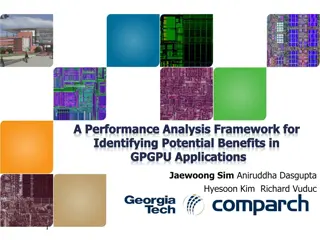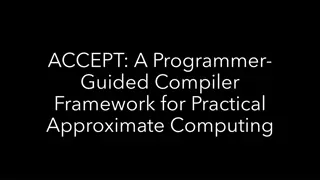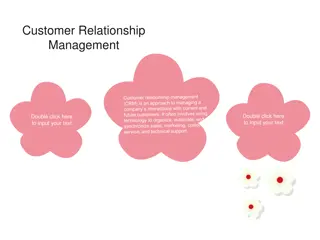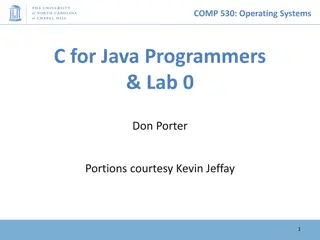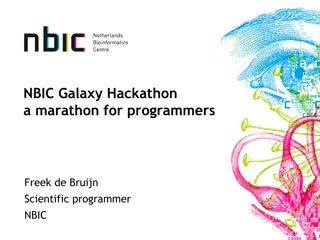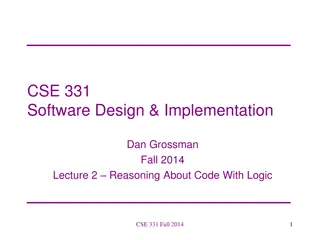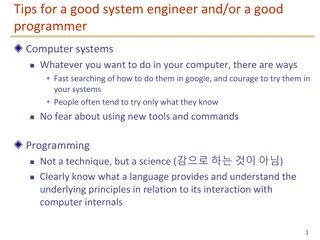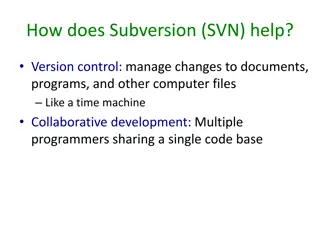Educating Programmers: A Customer Perspective
Many programmers lack the skills required for producing quality software. Programming as a serious discipline, with an extensive core curriculum covering system decomposition, component design, and programming aesthetics. Grounding in elementary mathematics provides necessary foundation.
Download Presentation

Please find below an Image/Link to download the presentation.
The content on the website is provided AS IS for your information and personal use only. It may not be sold, licensed, or shared on other websites without obtaining consent from the author.If you encounter any issues during the download, it is possible that the publisher has removed the file from their server.
You are allowed to download the files provided on this website for personal or commercial use, subject to the condition that they are used lawfully. All files are the property of their respective owners.
The content on the website is provided AS IS for your information and personal use only. It may not be sold, licensed, or shared on other websites without obtaining consent from the author.
E N D
Presentation Transcript
COMP 411: Computer Organization Performance Don Porter
COMP 411: Computer Organization Topics Defining Performance Performance Measures How to improve performance Performance pitfalls Examples
COMP 411: Computer Organization Why Study Performance? Helps us make intelligent design choices See through the marketing hype Key to understanding underlying computer organization Why is some hardware faster than others for different programs? What factors of system performance are hardware related? e.g., Do we need a new machine or a new operating system? How does a machine s instruction set affect its performance?
COMP 411: Computer Organization What is Performance? Loosely: How fast can a computer complete a task Examples of tasks : Short tasks: Crunch a bunch of numbers (say calculate mean) Display a PDF document Respond to a game console button press Longer ones: Search for a document on hard drive Rip a DVD into an mpg file Apply a Photoshop filter
COMP 411: Computer Organization Performance Metrics Latency: Time from input to corresponding output How long does it take for my program to run? How long must I wait after typing return for the result? Other examples? Throughput: Results produced per unit time How many results can be processed per second? What is the average execution rate of my program? How much work is getting done each second? Other examples?
Which airplane is best? COMP 411: Computer Organization Cruising range (miles) Passenger throughput (passengers x mph) Passenger capacity Cruising speed (mph) Airplane How to Define Best ?: Fastest? Farthest range? Most passenger capacity? Passenger-miles per hour?
Which airplane is best? COMP 411: Computer Organization Cruising range (miles) Passenger throughput (passengers x mph) Passenger capacity Cruising speed (mph) Airplane Boeing 777 Boeing 777 Boeing 747 Boeing 747 BAC/Sud Concorde BAC/Sud Concorde Douglas DC-8-50 Douglas DC-8-50 0 5000 10000 0 200 400 600 Cruising Range (miles) Passenger Capacity Boeing 777 Boeing 747 BAC/Sud Concorde Douglas DC-8-50 0 500 1000 1500 Cruising Speed (mph)
Which airplane is best? COMP 411: Computer Organization Cruising range (miles) Passenger throughput (passengers x mph) Passenger capacity Cruising speed (mph) Airplane How much faster is the Concorde than the 747? 1350 mph / 610 mph = 2.2 X ( X means factor of ) How much larger is the 747 s capacity than the Concorde? 470 passengers / 132 passengers = 3.6 X Note: X is a ratio no units
Which airplane is best? COMP 411: Computer Organization Cruising range (miles) Passenger throughput (passengers x mph) Passenger capacity Cruising speed (mph) Airplane It is roughly 4000 miles from Raleigh to Paris. What is the throughput of the 747 in passengers/hr? 610????? 4000 ?????= 71.7 ??????????/ ? 470 ?????????? ? The Concorde? 1350????? 4000 ?????= 44.6 ??????????/ ? 132 ?????????? ? What is the latency (trip time) of the 747? The Concorde? 4000 ????? 610 ?????/ ?= 6.56 ?? , 4000 ????? 1350 ?????/ ?= 2.96 ?? Note: Dimensional analysis is your friend
COMP 411: Computer Organization Performance Metrics Latency: Time from input to corresponding output Flight time from Raleigh to Paris How long does it take for my program to run? How long must I wait after typing return for the result? Other examples? Throughput: Results produced per unit time Passengers/hour How many results can be processed per second? What is the average execution rate of my program? How much work is getting done each second? Other examples?
COMP 411: Computer Organization Execution Time Elapsed Time/Wall Clock Time counts everything (disk and memory accesses, I/O, etc.) includes the impact of other programs a useful number, but often not good for comparison purposes CPU time does not include I/O or time spent running other programs can be broken up into system time, and user time Our focus: user CPU time time spent executing actual instructions of our program
COMP 411: Computer Organization Performance For some program running on machine X, PerformanceX = Program Executions / TimeX (executions/sec) = 1 / Execution TimeX Relative Performance "X is n times faster than Y PerformanceX / PerformanceY = n
COMP 411: Computer Organization Performance PerformanceX = 1 / Execution TimeX Relative Performance ( X is n times faster than Y ) n = PerformanceX / PerformanceY Example: Machine A runs a program in 20 seconds PerformanceA = 1/20 Machine B runs the same program in 25 seconds PerformanceB = 1/25 By how much is A faster than B? Machine A is (1/20)/(1/25) = 1.25 times faster than Machine B
COMP 411: Computer Organization Performance: Pitfalls of using % Same Example: Machine A runs a program in 20 sec; B takes 25 sec By how much is A faster than B? Is it (25-20)/25 = 20% faster? Is it (25-20)/20 = 25% faster? Correct answer is: A is (PerfA-PerfB)/PerB faster (0.05 - 0.04) / (0.04) = 25% faster By how much is B slower than A? Correct answer is: B is (PerfB-PerfA)/PerA faster/slower (0.04 - 0.05) / (0.05) = -20% faster = 20% slower Confusing: A is 25% faster than B; B is 20% slower Better: A is 1.25 times faster than B; B is 1/1.25 as fast Also: percentages are only good up to 100% Never say A is 13000% faster than B Neither immediately intuitive; voice of experience
COMP 411: Computer Organization CPU Clocking Operation of digital hardware governed by a constant-rate clock Clock period Clock (cycles) Data transfer and computation Update state Clock period: duration of a clock cycle e.g., 250ps = 0.25ns = 250 10 12s Clock frequency (rate): cycles per second e.g., 1/(0.25ns) = 4GHz = 4000MHz = 4.0 109Hz Water hose analogy
COMP 411: Computer Organization Program Clock Cycles Execution time often reported in cycle counts History: A newer generation of the same processor Used to have the same cycle counts for the same program But a faster clock speed (ex, 1 GHz changes to 1.5 GHz) Not really true anymore, but does focus on CPU performance Clock ticks indicate when machine state changes Abstraction: model time as discrete instead of continuous time Simple relation: CPU = Time CPU Clock Cycles Clock Cycle Time CPU Clock Cycles = Clock Rate
COMP 411: Computer Organization From Cycles to *seconds Relation: = CPU Time CPU Clock Cycles Clock Cycle Time CPU Clock Cycles = Clock Rate or: seconds program= cycles program seconds cycle cycle time = time between ticks = seconds per cycle clock rate (frequency) = cycles per second (1 Hz = 1 cycle/s) A 200 MHz clock has a cycle time of: 1 ????? 200 106 ??????/???= 5 10 9??????? = 5 ??
COMP 411: Computer Organization How Many Cycles in a Program? For some processors (e.g., MIPS processor) # of cycles == # of instructions 1st instruction 4th 5th 2nd instruction 3rd instruction 6th ... time This assumption can be incorrect, Different instructions take different amounts of time on different machines. Memory accesses might require more cycles than other instructions. Floating-Point instructions might require multiple clock cycles to execute. Branches might stall execution rate
COMP 411: Computer Organization Instruction Count and CPI Count n Instructio Cycles Clock = Cycles per Instructio n = CPU Time Instructio Count n CPI Clock Cycle Time Instructio Count n CPI = Clock Rate Instruction Count for a program Determined by program Instruction set architecture (ISA) compiler Average cycles per instruction ( CPI ) Determined by CPU hardware If different instructions have different CPI Average CPI affected by instruction mix
COMP 411: Computer Organization Now that we understand cycles A given program will require some number of instructions (machine instructions) some number of cycles some number of seconds We have a vocabulary that relates these quantities: cycle time (seconds per cycle) clock rate (cycles per second) CPI (average cycles per instruction) a floating point intensive application might have a higher CPI MIPS (millions of instructions per second) this would be higher for a program using simple instructions
COMP 411: Computer Organization Computer Performance Measure Millions of Instructions per Second Frequency in MHz clocks sec MIPS = AVE(clocks instruction) Unfortunate coincidence: This MIPS has nothing to do with the name of the MIPS processor we will be studying! CPI (Average Cycles Per Instruction) Historically: PDP-11, VAX, Intel 8086: Load/Store RISC machines MIPS, SPARC, PowerPC, miniMIPS: Modern CPUs, Pentium, Athlon : CPI > 1 CPI = 1 CPI < 1
COMP 411: Computer Organization How to Improve Performance? Many ways to write the same equations: seconds program= cycle MIPS=Freq cycles program seconds CPI So, to improve performance (everything else being equal) you can either ________ the # of required cycles for a program; ________ the clock cycle time or, said another way, ________ the clock rate; ________ the CPI (average clocks per instruction). Decrease Decrease Decrease Increase MIPS Pitfall Cannot compare MIPS of two different processors if they run different sets of instructions! ARM CPU clock rate not directly comparable to Intel ISA is different Meaningless Indicator of Processor Speed!
COMP 411: Computer Organization Example Our favorite program runs in 10 seconds on computer A, which has a 2 GHz clock. We are trying to help a computer designer build a new machine B, to run this program in 6 seconds. The designer can use new (or perhaps more expensive) technology to substantially increase the clock rate, but has informed us that this increase will affect the rest of the CPU design, causing machine B to require 1.2 times as many clock cycles as machine A for the same program. What clock rate should we tell the designer to target? cycles program= program ( second= seconds program ( )A cycles )B=1.2 2 1010 second=10 2 109=2 1010 =4 109=4GHz seconds cycles program cycles 6
COMP 411: Computer Organization Performance Traps Performance: What matters is the execution time of a program that you care about. Do any of the other variables (alone) equal performance? # of cycles to execute program? # of instructions in program? # of cycles per second? average # of cycles per instruction? average # of instructions per second? Common pitfall: Putting the blinders on, and focusing exclusively on one variable
COMP 411: Computer Organization CPI Example Suppose we have two implementations of the same instruction set architecture (ISA) If same ISA which quantity (clock rate, CPI) is the same? For some program: Computer A has a clock cycle time of 250 ps and a CPI of 2.0 Computer B has a clock cycle time of 500 ps and a CPI of 1.2 What machine is faster for this program, and by how much? TimeA= InstructionCount*CPIA*CycleTimeA = IC*2.0*250ps= IC*500ps TimeB= InstructionCount*CPIB*CycleTimeB = IC*1.2*500ps= IC*600ps Neither! Relative Performance=TimeB TimeA=600 500=1.2 A is faster by 1.2X
COMP 411: Computer Organization CPI in More Detail If different instruction classes take different numbers of cycles = 1 i n = Clock Cycles (CPI Instructio Count n ) i i Weighted average CPI: = Instructio Clock Cycles Instructio Count n n = i = CPI CPI i i Count n Instructio Count n 1 Relative frequency On most CPUs, CPI is a weighted average
COMP 411: Computer Organization Example: Compiler s Impact Two different compilers are being tested for a 500 MHz machine with three different classes of instructions: Class A, Class B, and Class C, which require one, two, and three cycles (respectively). Both compilers are used to produce code for a large piece of software. The first compiler's code uses 5 million Class A instructions, 1 million Class B instructions, and 2 million Class C instructions. The second compiler's code uses 7 million Class A instructions, 1 million Class B instructions, and 1 million Class C instructions. Which program uses fewer instructions? Instructions1 = (5+1+2) x 106 = 8 x 106 Instructions2 = (7+1+1) x 106 = 9 x 106 CPI1 = ? 13/8 = 1.625 Which sequence uses fewer clock cycles? Cycles1 = (5(1)+1(2)+2(3)) x 106 = 13 x 106 Cycles2 = (7(1)+1(2)+1(3)) x 106 = 12 x 106 CPI2 = ? 12/9 = 1.33
COMP 411: Computer Organization Another CPI Example Alternative compiled code versions using instructions in classes A, B, C Class CPI for class IC for version 1 IC for version 2 A 1 2 4 B 2 1 1 C 3 2 1 Version 1: IC = 5 Clock Cycles = 2 1 + 1 2 + 2 3 = 10 Avg. CPI = 10/5 = 2.0 Version 2: IC = 6 Clock Cycles = 4 1 + 1 2 + 1 3 = 9 Avg. CPI = 9/6 = 1.5
COMP 411: Computer Organization Performance Summary CPU Time=Instructions Clock cycles Instruction Seconds Clock cycle Program Performance depends on Algorithm: affects IC, possibly CPI Programming language: affects IC, CPI Compiler: affects IC, CPI Instruction set architecture: affects IC, CPI, Cycle Time
COMP 411: Computer Organization Comparing Computers So, if IPC, clock, etc. aren t good measures, what is? Execution time of the program you care about! But this is in the eye of the beholder Idea: Let s get a set of representative applications May not be perfect, or exactly what I care about But covers common use cases What might be good smartphone apps? 30
COMP 411: Computer Organization Benchmarks A set of applications for comparing execution time Use programs typical of expected workload Or, typical of expected class of applications e.g., compilers/editors, scientific applications, graphics, etc. Small benchmarks nice for architects and designers easy to standardize can be abused SPEC (System Performance Evaluation Cooperative) companies have agreed on a set of real program and inputs can still be abused valuable indicator of performance (and compiler technology)
COMP 411: Computer Organization SPEC 95 Description Artificial intelligence; plays the game of Go Motorola 88k chip simulator; runs test program The Gnu C compiler generating SPARC code Compresses and decompresses file in memory Lisp interpreter Image compression and decompression Manipulates strings and prime numbers in the special-purpose programming language Perl A database program A mesh generation program Shallow water model with 513 x 513 grid quantum physics; Monte Carlo simulation Astrophysics; Hydrodynamic Naiver Stokes equations Multigrid solver in 3-D potential field Parabolic/elliptic partial differential equations Simulates isotropic, homogeneous turbulence in a cube Solves problems regarding temperature, wind velocity, and distribution of pollutant Quantum chemistry Plasma physics; electromagnetic particle simulation Benchmark go m88ksim gcc compress li ijpeg perl vortex tomcatv swim su2cor hydro2d mgrid applu trub3d apsi fpppp wave5 Periodically updated with newer benchmarks:
COMP 411: Computer Organization SPEC 2006 Interesting to see how the mix of applications has changed over the years See http://www.spec.org/cpu2006/{CINT2006, CFP2006} 33
COMP 411: Computer Organization Other Popular Benchmarks Desktop: Phoronix File System: Filebench Java VM: DaCapo Cloud: Cloudbench Same goal: Standardize & compare end-user perf.
COMP 411: Computer Organization Amdahl s Law Possibly the most important law on performance: timproved=taffected +tunaffected rspeedup Informally: The law of diminishing returns Eventually, performance gains will be limited by what cannot be improved Paris flight example: I spend 1 hour in take- off/taxi/landing, and 6 in the air. If I improve take-off time, what is the fastest I will get to Paris? 6 hours if I could instantly jump into the air from parked Implication: Make the common case fast
COMP 411: Computer Organization Amdahl s Law: Example timproved=taffected rspeedup +tunaffected Example: "Suppose a program runs in 100 seconds on a machine, where multiplies are executed 80% of the time. How much do we need to improve the speed of multiplication if we want the program to run 4 times faster?" 25 = 80/r + 20 r = 16x How about making it 5 times faster? 20 = 80/r + 20 r = ?
COMP 411: Computer Organization Example Suppose we enhance a machine making all floating-point instructions run FIVE times faster. If the execution time of some benchmark before the floating-point enhancement is 10 seconds, what will the speedup be if only half of the 10 seconds is spent executing floating-point instructions? 5/5 + 5 = 6 Relative Perf = 10/6 = 1.67 x
COMP 411: Computer Organization Example We are looking for a benchmark to show off the new floating- point unit described above, and want the overall benchmark to show at least a speedup of 3. What percentage of the execution time would floating-point instructions have to account for in this program in order to yield our desired speedup on this benchmark? Recall: we make floating point 5x faster 100/3 = f/5 + (100 f) = 100 4f/5 f = 83.33
COMP 411: Computer Organization Design Tradeoffs Performance is rarely the sole factor Cost is important too Energy/power consumption is often critical Frequently used compound metrics Performance/Cost (throughput/$) Performance/Power (throughput/watt) Work/Energy (total work done per joule) for battery-powered devices 39
COMP 411: Computer Organization Power Consumption Power = Energy consumed per unit time Two contributors to power consumption Dynamic power power consumed when doing actual work called dynamic because components and wires are switching between 0 and 1 Static or leakage power power consumed even when everything is idle or static due to some small amount of leakage current that still flows
COMP 411: Computer Organization Dynamic Power Consumption Energy consumed due to switching activity: Remember the model of gates as on/off switches? This burns energy All wires and transistor gates have capacitance, or the ability to store electric charge Energy required to charge a capacitance, C, to VDD is CVDD2 Energy = CVDD2 C is the total capacitance of circuit ( capacitive load ) VDD is the supply voltage f is the switching frequency
COMP 411: Computer Organization Dynamic Power Consumption Energy consumed due to switching activity: Energy = CVDD2 Circuit running at frequency f: transistors switch (from 1 to 0 or vice versa) at that frequency Capacitor is charged f/2 times per second assume 50% chance switching from 0 to 1 additional energy drawn from battery CVDD2 assume 50% chance switching from 1 to 0 no additional energy taken from battery stored energy is discharged Pdynamic = CVDD2 *f/2 = CVDD2f C is the total capacitance of circuit ( capacitive load ) VDD is the supply voltage f is the switching frequency
COMP 411: Computer Organization Static Power Consumption Power consumed when no gates are switching Caused by the quiescent supply current, IDD (also called the leakage current) Pstatic or Pleakage = IDDVDD VDD is the supply voltage IDD is the leakage current
COMP 411: Computer Organization Combining Dynamic + Static P = CVDD2f + IDDVDD C is the total capacitance of circuit ( capacitive load ) VDD is the supply voltage IDD is the leakage current f is the switching frequency
COMP 411: Computer Organization Power Consumption Example Estimate the power consumption of a wireless handheld computer VDD = 1.2 V C = 20 nF f = 1 GHz IDD = 20 mA 1 Hz = 1 second -1 C is the total capacitance of circuit ( capacitive load ) VDD is the supply voltage IDD is the leakage current f is the switching frequency 1 F = 1 (W *s) / Volt2 1 W = 1 V * 1 A P = CVDD2f + IDDVDD = (20 nF)(1.2 V)2(1 GHz) + (20 mA)(1.2 V) = 14.4 W + 24 mW = 14.424 W
COMP 411: Computer Organization Power Trends In CMOS IC technology Dynamic Power =1 2Capacitive load Voltage2 Frequency 30 5V 1V 1000 Note: Frequency may also be called clock rate/frequency or frequency switched
COMP 411: Computer Organization Reducing Dynamic Power Dynamic Power =1 2Capacitive load Voltage2 Frequency Suppose a new CPU has 85% of capacitive load of old CPU 15% voltage and 15% frequency reduction =Cold 0.85 (Vold 0.85)2 Fold 0.85 Cold Vold Pnew Pold =0.854=0.52 2 Fold About a 50% reduction in power
COMP 411: Computer Organization The Power Wall Hard physical realities: It is hard to reduce voltage below a certain point Leakage starts to dominate results Garden hose analogy: hard to differentiate water left in hose from real output Circuit outputs become unstable We can only dissipate so much heat from a cm2 of surface area Fancier cooling possible: liquids, larger heat sinks But not in my phone! 48
COMP 411: Computer Organization Fallacy: Low Power at Idle AMD X4 power benchmark: At 100% load: 295W (max power) At 50% load: 246W (83% max power) At 10% load: 180W (still consumes 61% of max power) Google data center Mostly operates at 10% - 50% load At 100% load less than 1% of the time Open Problem: Design processors to make power proportional to load
COMP 411: Computer Organization Moore s Law: Uniprocessor Perf. Constrained by power, instruction-level parallelism, memory latency 50
